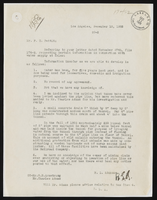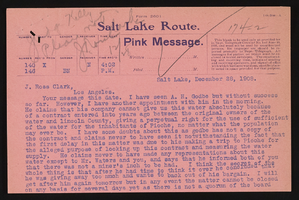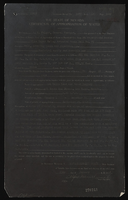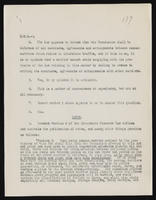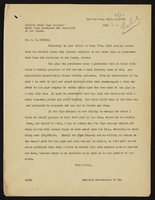Search the Special Collections and Archives Portal
Search Results

Telegram from Walter R. Bracken (Las Vegas) to E. E. Calvin (Omaha), July 17, 1923
Date
Archival Collection
Description
Las Vegas was experiencing low water pressure because the fruit company was using full head through a direct 8 in. water main. Their cooling tower was installed, but not in service. Bracken wondered if there was a way to compel them to either use the tower or dig a well.
Text

Letter from F. H. Knickerbocker to A. L. Coey, June 6, 1933
Date
Archival Collection
Description
After the discovery of a dead man in a swimming hole on Union Pacific property, the removal of the swimming hole was suggested.
Text

Telegram from Walter R. Bracken (Las Vegas) to J. P. Mack (Los Angeles), March 11, 1939
Date
Archival Collection
Description
Walter Bracken urging the Union Pacific Railroad Company that serious maintenance needs to be made to a wooden pipeline which was leaking badly in numerous places with summer quickly approaching.
Text

Telegram from Walter R. Bracken (Las Vegas) to J. P. Mack (Los Angeles), June 10, 1939
Date
Archival Collection
Description
Walter Bracken urging the Union Pacific Railroad to pay serious attention to maintaining a wooden pipeline, which was leaking badly in numerous places in summer. The reservoir level was at seven feet and falling.
Text


